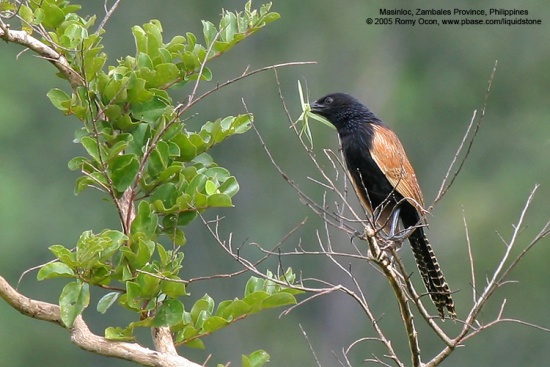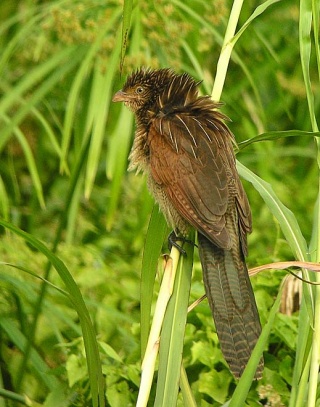(info added, picture of immature added) |
|||
| Line 1: | Line 1: | ||
| + | [[Image:Lesser_Coucal.jpg|thumb|550px|right|Photo by {{user|Romy+Ocon|Romy Ocon}}<br/>Masinloc, Zambales, [[Philippines]]]] | ||
| + | '''Alternative name: Small Coucal''' | ||
;[[:Category:Centropus|Centropus]] bengalensis | ;[[:Category:Centropus|Centropus]] bengalensis | ||
| − | |||
==Identification== | ==Identification== | ||
| − | 38cm | + | [[Image:1568lesser coucal immDSCN1318.jpg|thumb|320px|right|Immature<br />Photo by {{user|Neil|Neil}}<br/> Hong Kong, [[China]], January 2007]] |
| + | 31 - 38cm. | ||
| + | * Black upperparts and underparts, often with pale streaking | ||
| + | * Pale rufous brown wings | ||
| + | * Glossy black tail narrowly tipped whitish | ||
| + | * Red to brown eye | ||
| + | * Black bill and legs | ||
| + | * In non-breeding plumage barred brown upperparts and rufous-white underparts with dusky bars | ||
| + | * Subspecies differ mainly in size, ''sarasinorum'' is larger and darker than nominate, ''medius'' larger still | ||
| + | Sexes alike, females larger. Juveniles are dark brown above, light rufous barred, streaked rufous on head and back, have buffy-white shaft-streaks and are whitish buff below with paler shaft streaks and bars. | ||
==Distribution== | ==Distribution== | ||
| − | [[India]] to | + | From [[India]] est to southern [[China]], [[Indochina]], [[Malaysia]], [[Sumatra]], [[Borneo]], the [[Philippines]], the [[Lesser Sundas]] and [[Moluccas]].<br /> |
| + | Common in suitable habitat in its range. | ||
==Taxonomy== | ==Taxonomy== | ||
| − | + | Five subspecies recognized: | |
| − | * '' | + | * ''C. b. bengalensis'' from [[India]] and [[Nepal]] to [[Bangladesh]], [[Burma]] and [[Indochina]] |
| − | * '' | + | * ''C. b. lignator'' in southern and southeast [[China]], Hainan and [[Taiwan]] |
| − | * '' | + | * ''C. b. javanensis'' from the [[Malay Peninsula]] to [[Sumatra]], [[Java]], [[Borneo]], Palawan and the [[Philippines]] |
| − | * '' | + | * ''C. b. sarasinorum'' on [[Sulawesi]] and the [[Lesser Sundas]] ([[Indonesia]]) |
| − | * '' | + | * ''C. b. medius'' on the [[Moluccas]] ([[Indonesia]]) |
| − | + | Has been considered conspecific with [[Black Coucal]] and [[Madagascar Coucal]]. | |
==Habitat== | ==Habitat== | ||
| − | Open grasslands, both dry and marshy. | + | Open grasslands, both dry and marshy. In more open habitats than [[Greater Coucal]].<br /> |
| − | + | From lowlands up to 1800m. | |
==Behaviour== | ==Behaviour== | ||
| − | Diet | + | ====Diet==== |
| − | + | Feeds on large insects, frogs, lizards, snakes, fruit. They hunt these among the undergrowth, using their powerful bills to catch and kill their prey. | |
| − | They build a large globe nest made of twigs or grass (blades and stems) with a large entrance hole to one side. The nest is sometimes lined with green leaves and grass. | + | ====Breeding==== |
| − | + | Breeding season starts in [[India]] after onset of rains In June, December to July in the [[Malay Peninsula]]. They build a large globe nest made of twigs or grass (blades and stems) with a large entrance hole to one side. The nest is sometimes lined with green leaves and grass. 2-4 white eggs are laid. Both sexes incubate and tend the young. | |
| + | ====Movements==== | ||
| + | This is a resident species. Locally perhaps only a summer visitor, e.g. in [[Nepal]]. | ||
| + | ==References== | ||
| + | #{{Ref-Clements6thAug13}}#{{Ref-HBWVol4}} | ||
| + | {{ref}} | ||
==External Links== | ==External Links== | ||
{{GSearch|Centropus+bengalensis}} | {{GSearch|Centropus+bengalensis}} | ||
| − | |||
[[Category:Birds]] [[Category:Centropus]] | [[Category:Birds]] [[Category:Centropus]] | ||
Revision as of 10:00, 8 October 2013
Alternative name: Small Coucal
- Centropus bengalensis
Identification
31 - 38cm.
- Black upperparts and underparts, often with pale streaking
- Pale rufous brown wings
- Glossy black tail narrowly tipped whitish
- Red to brown eye
- Black bill and legs
- In non-breeding plumage barred brown upperparts and rufous-white underparts with dusky bars
- Subspecies differ mainly in size, sarasinorum is larger and darker than nominate, medius larger still
Sexes alike, females larger. Juveniles are dark brown above, light rufous barred, streaked rufous on head and back, have buffy-white shaft-streaks and are whitish buff below with paler shaft streaks and bars.
Distribution
From India est to southern China, Indochina, Malaysia, Sumatra, Borneo, the Philippines, the Lesser Sundas and Moluccas.
Common in suitable habitat in its range.
Taxonomy
Five subspecies recognized:
- C. b. bengalensis from India and Nepal to Bangladesh, Burma and Indochina
- C. b. lignator in southern and southeast China, Hainan and Taiwan
- C. b. javanensis from the Malay Peninsula to Sumatra, Java, Borneo, Palawan and the Philippines
- C. b. sarasinorum on Sulawesi and the Lesser Sundas (Indonesia)
- C. b. medius on the Moluccas (Indonesia)
Has been considered conspecific with Black Coucal and Madagascar Coucal.
Habitat
Open grasslands, both dry and marshy. In more open habitats than Greater Coucal.
From lowlands up to 1800m.
Behaviour
Diet
Feeds on large insects, frogs, lizards, snakes, fruit. They hunt these among the undergrowth, using their powerful bills to catch and kill their prey.
Breeding
Breeding season starts in India after onset of rains In June, December to July in the Malay Peninsula. They build a large globe nest made of twigs or grass (blades and stems) with a large entrance hole to one side. The nest is sometimes lined with green leaves and grass. 2-4 white eggs are laid. Both sexes incubate and tend the young.
Movements
This is a resident species. Locally perhaps only a summer visitor, e.g. in Nepal.
References
- Clements, J. F., T. S. Schulenberg, M. J. Iliff, B.L. Sullivan, C. L. Wood, and D. Roberson. 2013. The eBird/Clements checklist of birds of the world: Version 6.8., with updates to August 2013. Downloaded from http://www.birds.cornell.edu/clementschecklist/download/
- Del Hoyo, J, A Elliot, and J Sargatal, eds. 1997. Handbook of the Birds of the World. Volume 4: Sandgrouse to Cuckoos. Barcelona: Lynx Edicions. ISBN 978-8487334221
Recommended Citation
- BirdForum Opus contributors. (2024) Lesser Coucal. In: BirdForum, the forum for wild birds and birding. Retrieved 23 April 2024 from https://www.birdforum.net/opus/Lesser_Coucal





